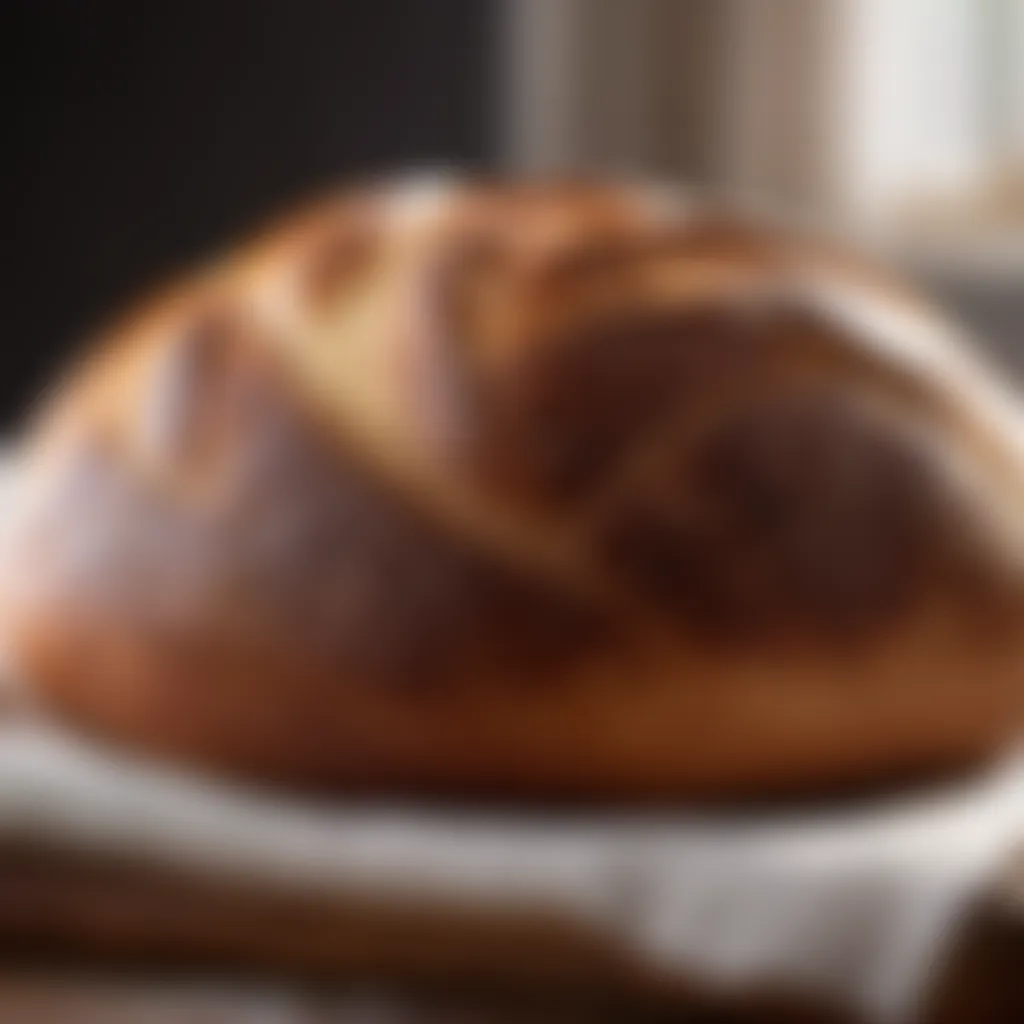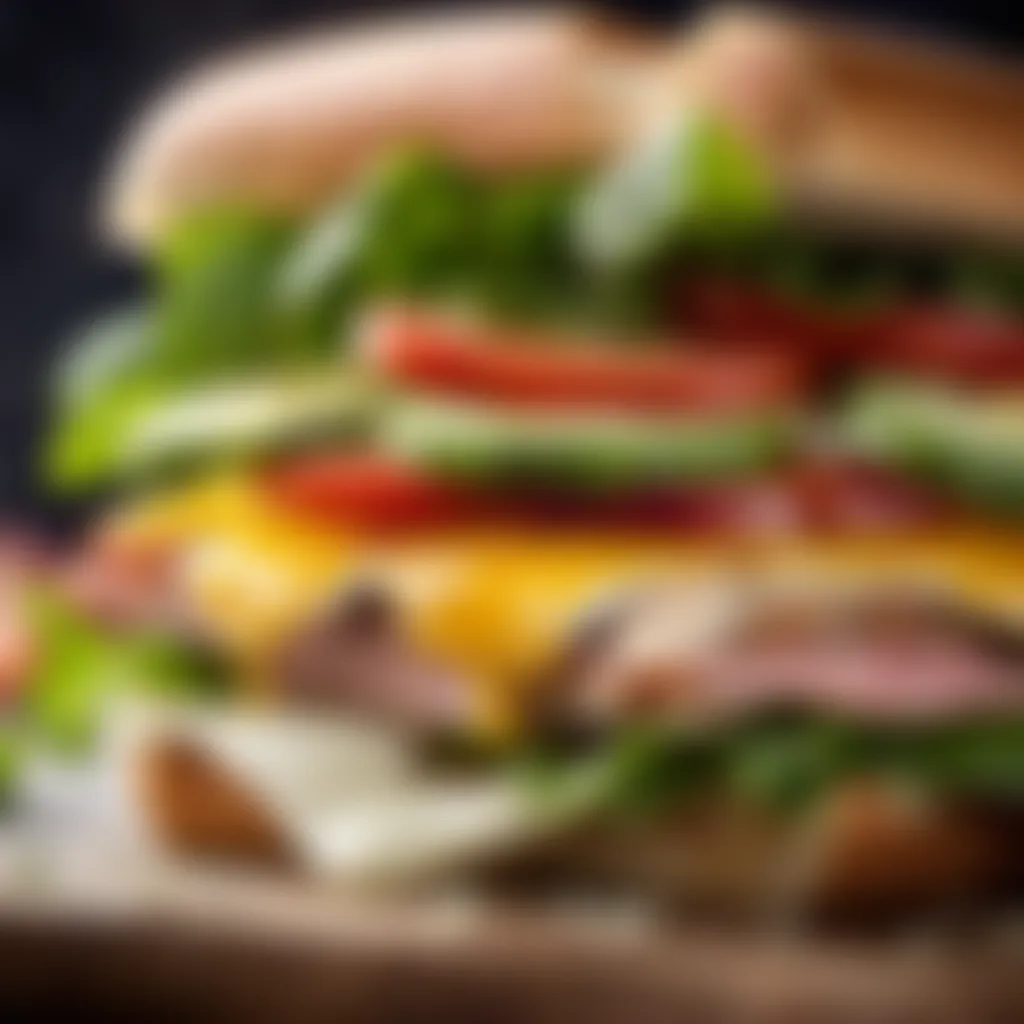Gjusta Recipe: A Comprehensive Guide to Its Preparation


Intro
In the realm of culinary exploration, some dishes simply shine with their complex flavors and textures. Gjusta stands out as an epitome of such culinary artistry. This dish is more than just a meal; it’s an experience that brings together an array of ingredients and techniques, resulting in something truly remarkable. As we embark on this detailed guide to prepare Gjusta, we’ll uncover not only the necessary ingredients but also the methods and principles that make this dish a standout.
By the time you finish this guide, you'll be equipped not just to replicate the Gjusta flavor, but also to comprehend the very essence of its creation. Let’s roll up our sleeves and dive into the heart of this delightful dish.
Intro to Gjusta
The Gjusta has become a favorite among culinary enthusiasts and casual home cooks alike. With its rich textures and vibrant flavors, it brings a hearty element to any meal. This section aims to shed light on Gjusta and help readers appreciate its unique nature while laying the groundwork for deeper exploration into its history, cultural relevance, and preparation complexities.
Understanding Gjusta is not just about the food itself; it's about grasping the artistry involved in its making. Every forkful tells a story of meticulous selection of ingredients and the techniques used to combine them. This dish isn’t simply another recipe—it's a canvas upon which cooks can express their creativity and pay homage to culinary traditions.
Understanding Its Origin
The origins of Gjusta can be traced back to various traditional recipes rooted in Mediterranean cuisine. The dish embodies a blend of regional flavors and practices that have evolved over time. While specifics may vary significantly from one household or community to another, what remains constant is the reliance on fresh, high-quality components.
The gastronomical journey of Gjusta reflects not only a dedication to food but also an inclination to gather family and friends around the table. Here, sharing a meal turns into a cultural ritual that transcends generations. Each bite is crafted with care, using techniques that hint at a long-standing culinary heritage, thereby creating an experience that lingers in memory.
Cultural Significance
Beyond its origin, Gjusta is steeped in cultural importance. The dish often finds itself in gatherings, symbolizing hospitality and fellowship. It is not merely an assortment of ingredients; it's an invitation into a world where flavors collide and traditions intertwine.
Cooking Gjusta is an act of love—creating it means indulging in culinary practices that various communities have nurtured over decades. One can almost feel the echo of laughter and stories shared over the dining table with every forkful. This cultural significance is what elevates the dish from a mere meal to a treasured ritual, fostering connections among those who gather to enjoy it.
"Food is more than just fuel; it's a memory, a feeling, and a bridge connecting hearts across generations."
In exploring Gjusta, this connection's depth enhances our culinary ventures. It's about embracing the art of preparation and recognizing the moments that infuse life into the kitchen.
Essential Ingredients
Understanding the essential ingredients of the Gjusta recipe offers a glimpse into the heart of its culinary brilliance. Each component contributes to the overall flavor, texture, and authenticity of the dish, playing a crucial role in the final presentation and taste.
Primary Components
At the foundation of any Gjusta recipe are its primary components, which typically comprise fresh fish, vegetables, and grains. Smoked fish, such as salmon or trout, is often the star of the show, adored for its rich flavor and flaky texture. The smokiness contributes complexity and depth, serving as a canvas for various seasonings.
Fresh veggies like cucumbers and radishes add a crisp contrast, while grains such as quinoa or barley provide a hearty base. When combined, these ingredients create a harmonious balance that elevates the dish.
- Fish: Opt for high-quality, sustainably sourced varieties.
- Vegetables: Choose seasonal produce for the best taste and freshness.
- Grains: Whole grains not only enhance texture but also add nutritional value.
Choosing Quality Ingredients
Selecting the right ingredients can make or break the Gjusta experience. Quality is paramount, particularly when it comes to fish. Look for fish that’s fresh and smells clean like the ocean – you wouldn’t want anything fishy here! When using vegetables, vibrant colors indicate freshness.\ Farmers’ markets or specialty stores often have superior produce compared to generic grocery stores.
Here are some tips to get the cream of the crop:
- Check for sustainability certifications on seafood.
- Ask your local fishmonger for the freshest catch available.
- Inspect the firmness and color of vegetables; wilting is a no-go.
Substitutions and Variations
Not everyone has access to the same ingredients, and that’s completely fine! Flexibility is key when preparing Gjusta. If smoked fish isn’t available, consider using cooked shrimp or crab. For a plant-based version, smoked tofu can give a similar umami effect.
Vegetable variations can include avocados for creaminess or peppers for sweetness, allowing you to tailor the dish to your tastes. Similarly, the grain base can be replaced with riced cauliflower for a lower-carb option.
Versatility ensures that anyone can enjoy this dish, regardless of dietary preferences or ingredient availability.
In summary, the essential ingredients lay the groundwork for creating an outstanding Gjusta dish. By carefully selecting quality components and being open to substitutions and variations, one can truly personalize this recipe to fit one’s palate.


Preparation Techniques
In creating the perfect Gjusta, the preparation techniques you employ can make all the difference. These methods are not mere steps in a recipe; they are crucial to the overall success of the dish. Mastering these techniques ensures that every component contributes deliciously to the dish's complexity. From how you handle your ingredients to the specific cooking strategies, understanding these aspects will elevate your culinary experience.
Initial Preparations
Before even thinking about cooking, the initial preparation sets the stage. This stage often includes the selection of fresh produce, proper washing, and peeling, if necessary. It’s quite like setting your house in order before guests arrive. Clean, organized work will save you headaches later on.
- Selecting Ingredients: Start by choosing ingredients that are fresh and in season. This not only guarantees better taste but also enhances nutritional value. For Gjusta, look for ripe tomatoes, crisp vegetables, and quality proteins.
- Preparing Your Workspace: Keep your kitchen tidy. Gather all necessary utensils and ingredients so that everything is within reach. It really helps to have a clutter-free workspace. A clean counter goes a long way in maintaining mental clarity.
Cooking Methods
The Gjusta is known for its various cooking methods, each contributing unique flavors and textures. Understanding these can help you find the right balance for your dish, much like weaving a beautiful tapestry. Here are some methods that are commonly employed:
- Roasting: This method is vital for developing rich flavors in your vegetables. As vegetables caramelize, they concentrate their natural sweetness, adding depth to the overall dish.
- Sautéing: Quick and efficient, sautéing allows for preservation of the ingredients' freshness and texture. It’s perfect for proteins that require a quick cook on high heat to lock in flavors.
- Slow Cooking: If time is on your side, slow cooking can produce melt-in-your-mouth results. This method is particularly good for tough cuts of meat, turning them tender with an infusion of spices.
"Cooking techniques are like the brush strokes to a painter; the better your methods, the more beautiful your results!"
Layering Flavors
Now, we arrive at the artistry of flavor layering. Just like building a house, you don’t want to throw everything together willy-nilly. Layering flavors requires thoughtfulness and attention to detail:
- Start with Base Flavors: Aromatics like garlic and onions lay the groundwork. Cooking them gently creates a flavorful base that will enhance every subsequent ingredient added.
- Add Elements Gradually: Add ingredients in stages to control how flavors infuse. For example, spices should often be added early, while fresh herbs are better suited for finishing touches, preserving their vibrant qualities.
- Taste as You Go: This is perhaps the most crucial tip. Regularly sampling allows you to adjust seasonings and ensure everything is harmoniously balanced.
By mastering these preparation techniques, you'll be on the path to making a Gjusta that not only satisfies the palate but also nurtures a deeper understanding of culinary practices. Each of these methods contributes to crafting a dish that feels both personal and sophisticated.
A Step-by-Step Guide
Cooking is an art form that requires precision and careful planning, much like composing a symphony or painting an exquisite landscape. The step-by-step guide serves as the backbone of our culinary journey with the Gjusta recipe, allowing us to methodically navigate the process from start to finish. When preparing a dish that has the potential to enchant both the palate and the soul, having a structured approach is invaluable. It ensures that each ingredient shines in its own right and that all flavors unite harmoniously.
Gathering the Equipment
Before diving into the rich world of flavors and textures, gathering the necessary equipment is crucial. Having the right tools on hand can make the cooking process smoother and more enjoyable. You'll want to set up a well-organized workspace.
Some essential items for preparing Gjusta include:
- Chopping board: For efficient ingredient prep.
- Sharp knives: To ensure clean cuts.
- Mixing bowls: For combining ingredients.
- Measuring cups and spoons: Accuracy is key in any recipe.
- Baking trays or skillets: Depending on your chosen cooking method, you might need several, so it’s helpful to have options.
- Whisk and spatula: Useful for mixing and scraping those last bits of goodness from the bowl.
- Oven or stove: Essential for bringing your dish to life.
Having these tools at your fingertips not only enhances productivity but also fosters creativity in the kitchen.
Measuring and Mixing Ingredients
Proper measurement of your ingredients is non-negotiable. It’s not just about throwing everything into a bowl and calling it good. Understanding the quantity and proportion of each component allows the flavors to coexist without one overpowering the other.
Start by:
- Carefully measuring each ingredient. A kitchen scale can be quite handy to ensure nothing goes astray, especially with spices and dry goods.
- Mixing them in the correct order. Some ingredients benefit from being incorporated sequentially rather than all at once. For example, when preparing a marinade, blend the acidic components first before introducing herbs and aromatics to achieve a well-rounded flavor.
- Observing texture changes as you mix. Are the ingredients combining beautifully? Is the dough too sticky or dry? Adjust per your observations; this is where your intuition plays a vital role.
Cooking Time and Temperature
Cooking time and temperature are the critical factors that can make or break your Gjusta creation. Each ingredient has its ideal cooking temperature and time, which ensures it retains its flavor and texture.
- Low and slow may work wonders for some items, allowing flavors to meld without burning.
- High heat might be perfect for crisping up elements or achieving that golden touch where appropriate.
As you cook, keep an eye on the clock and adjust the temperature as needed. A good rule of thumb is to use a thermometer to verify meat or baked goods. Don’t rely solely on timing; trusting your instincts and senses is equally important.
Plating and Presentation


Even though what’s on a plate matters, how it’s presented is equally essential. The aesthetics can elevate your dish from mere food to a dining experience. Here are notable tips for plating your Gjusta:
- Start with a clean plate. Wipe any splatters for an organized presentation.
- Choose a focal point. The central item should catch the eye—typically the protein or main part of the dish.
- Consider layering. If you have components with different textures—crunchy, creamy, etc.—stack them artfully.
- Introduce color and contrast by adding garnishes—fresh herbs, colorful veggies, or a dash of sauce can create a visual delight.
Proper plating is like putting the cherry on top. It speaks volumes and gives an extra touch of care and thoughtfulness to your dish.
By following these steps meticulously, not only will you enjoy the cooking process, but you’ll also create something that’s sure to impress. Cooking is as much about the journey as it is the destination!
Flavor Profile Analysis
Analyzing the flavor profile of Gjusta is essential, as it offers insights into what makes this dish truly special. Understanding how flavors interact is critical for achieving a harmonious result. All the flavors work together to create balance, depth, and an inviting experience that goes beyond mere taste.
Balancing Elements
When it comes to flavor, achieving balance is akin to walking a tightrope. You want to ensure that no single element overshadows the others. The richness of the proteins, for instance, needs a counterpoint in acidity, often found in the freshly squeezed lemon juice or pickled vegetables. This interplay can transform a dish from ordinary to extraordinary.
- Sweetness: Employ fruits or sweet components to lay the groundwork.
- Sourness: Then add a splash of acidity to cut through richness.
- Bitterness: Introduce some bitter greens to add complexity to the palate.
- Saltiness: Finally, season judiciously to enhance all the flavors without overwhelming them.
By keeping these elements in mind, you can create a Gjusta that tantalizes the taste buds while driving home the core essence of the dish.
Identifying Key Flavors
To make a notable Gjusta, one should pinpoint the key flavors that define the essence of the dish. Experimenting with these can be the difference between good and great.
- Smoky Undertones: This often comes from the proteins used or specific cooking methods like smoking or grilling.
- Fresh Herbs: Ingredients like dill, cilantro, or parsley can brighten up the entire dish. Freshness is key here!
- Spices: A hint of cumin or coriander can elevate the flavor without making it too overwhelming.
- Umami Factors: Ingredients like fermented products or matured cheeses can introduce that savory note that complements the dish perfectly.
Recognizing these flavors allows for adjustments and personalization which reflects your own culinary style.
Pairing with Accompaniments
Pairing Gjusta with suitable accompaniments is crucial for enhancing the overall experience. A well-paired side can amplify the dish's flavors and contribute complexity.
- Breads: Think about a good sourdough or rye bread that can soak in the juices.
- Salads: A light, citrusy salad can provide a refreshing contrast.
- Dips and Spreads: Consider homemade tzatziki or hummus to add texture and creaminess.
- Beverages: Wine or kombucha can cleanse the palate in between bites.
When you successfully match the main flavors and textures, every bite becomes an adventure, allowing the eater to appreciate the nuanced combinations.
Common Mistakes and Solutions
In the culinary world, even the most seasoned chefs can find themselves facing hiccups. When it comes to mastering the Gjusta recipe, avoiding common mistakes can mean the difference between a stunning dish and a mediocre one. This section highlights frequent pitfalls and provides practical solutions designed to enhance your cooking experience and the final product.
Overcooking Issues
Overcooking can quickly turn a promising dish into a culinary calamity. The texture of your main ingredients, often veggies or proteins, can be severely affected, transforming them from vibrant and appetizing to mushy and bland. The key here is understanding the right cooking times and methods.
Using a digital thermometer can be helpful to gauge the doneness of meats or other proteins effectively. For example, a well-cooked salmon fillet should register around 145 degrees Fahrenheit. Additionally, keeping a close eye on the clock while cooking is essential; a minute or two can often mean a world of difference in texture.
"Timing is everything in cooking; you may have to adjust based on your stove and the quality of your ingredients."
To mitigate the risk of overcooking, consider trying these tips:
- Practice mise en place: This French culinary phrase means everything in its place. By preparing your ingredients ahead of time, you can focus more on cooking than scrambling to get everything ready.
- Start high and go low: For vegetables, starting with a high heat allows searing which locks in flavor. Then, lowering the heat can help them cook evenly without excess moisture ruining textures.
Underseasoning Dilemmas
Have you ever tasted a dish that left you underwhelmed, wishing it had just a bit more flavor? Underseasoning is a trap many fall into, thinking that less is more. However, achieving a perfectly seasoned Gjusta isn’t just about quantity; it’s about balance.
Herbs, spices, and salts all play a critical role in elevating your flavors. Using a base layer of seasoning can help, often with ingredients like garlic, onion, and a pinch of salt, as these flavors have the power to blossom throughout the dish. Remember to taste as you go—this is one of the best practices to ensure seasoning is on point.


Here are some fundamentals to tackle underseasoning:
- Season in stages: Add salt when cooking at each stage, whether you are sautéing onions or layering sauces.
- Experiment with umami-rich ingredients: Ingredients like soy sauce, tomatoes, or mushrooms pack a flavorful punch that can significantly enhance the overall taste of your dish.
Ingredient Failures
Sometimes the stars of your dish can fail to shine due to quality or compatibility issues. Subpar ingredients can lead to disappointing results no matter how skilled you are in the kitchen. Learning how to assess the freshness and quality of your ingredients is crucial.
For example, when selecting vegetables, look for vibrancy and a firm touch. If your tomatoes are mushy or have an off-smell, they may not serve your Gjusta well. Similarly, proteins like fish should have a fresh, clean scent rather than any fishy odors.
When facing ingredient failures, consider:
- Keeping backups: If using herbs that are out of season, have dried alternatives ready. Though fresh is best, dried can still save the day.
- Understanding substitutions: If you can’t find a certain ingredient, research substitutes that won’t compromise flavor. For example, if basil is unavailable, oregano can lend a different but tolerable flavor.
By being aware of these common mistakes, you can navigate through the art of creating Gjusta more smoothly, ensuring tasty outcomes time after time.
Variations of the Gjusta Recipe
Exploring the variations of the Gjusta recipe offers a delightful opportunity to customize this dish according to various preferences and dietary needs. It’s not just about altering ingredients; it’s about embracing the creativity in cooking. These variations are not merely whimsical—each version carries its own story and connection to its cultural roots. By diving into the adaptability of Gjusta, you can tap into flavors that are better suited to local palettes or personal dietary restrictions.
Regional Differences
Every region has its own unique twist on the Gjusta recipe, often reflective of local ingredients, traditions, and even cooking techniques. For instance, in coastal areas, seafood varieties like smoked salmon might take center stage, while inland variations might rely on hearty local meats.
Here are some regional variations:
- Mediterranean Gjusta uses ingredients like olives, feta cheese, or roasted peppers, giving it a sun-kissed flavor profile.
- Northern Italian styles may include rich ingredients such as truffle oil drizzled over cured meats, resulting in a distinctly aromatic dish.
- Southern versions may bring in a more vibrant palette with additions like fresh herbs, tomatoes, and even citrus meringue topping.
Exploring these differences not only allows for personal preference but elevates the dish, reflecting the colors and culture of the region it represents. It uncovers hidden gems in local markets or farmers' stands you might otherwise overlook.
Adapting for Dietary Needs
When making Gjusta, it’s essential to consider dietary needs that reflect your family or guests. Today, more folks are leaning towards health-conscious choices, and adapting the recipe can make it more inclusive.
For instance:
- Gluten-Free: Substitute traditional breads with gluten-free options. Many local shops offer nutritious gluten-free bread that can hold up well.
- Vegan Adaptation: Instead of using smoked salmon or creamy dressings, consider options like smoked tofu or a cashew-based cream. These substitutions can provide the texture without compromising taste.
- Low-Carb: If you're on a keto journey, you might use cauliflower rice as a base instead of traditional grain.
Incorporating such changes not only meets dietary restrictions but also shows effort and care in meal planning, making everyone feel included.
Adapting recipes, especially beloved ones like Gjusta, is about crafting experiences that everyone can enjoy. Each variation speaks not just to taste, but to the understanding that food is a central part of our conversations and gatherings.
Whether you’re drawing inspiration from local variations or catering to specific dietary needs, variations of Gjusta can open up a world of delicious possibilities. Embrace the change, and let your culinary journey begin.
Culmination
As we wrap up our exploration of the Gjusta recipe, it’s paramount to recognize the importance of what we’ve covered. This conclusion serves as not just a summary, but also as a call to embrace the culinary journey. The Gjusta, with its intricate layers of flavor and texture, is more than a meal; it’s an opportunity for creativity and personal expression in the kitchen. Every step, from choosing ingredients to plating, reflects a careful consideration of flavors and presentation.
Recap of Key Insights
Throughout this article, we’ve delved into numerous facets of the Gjusta, uncovering essential insights along the way. A few key points to remember include:
- Ingredient Integrity: Selecting high-quality, fresh ingredients lays down the foundation for a sumptuous dish. The flavor profile is greatly influenced by the quality of components, from the meats to the herbs.
- Preparation Techniques: Understanding how to properly prepare and layer flavors transforms an ordinary dish into something extraordinary. Mastery of various cooking methods is crucial, whether it's smoking, roasting, or seasoning.
- Avoiding Pitfalls: Recognizing and rectifying common mistakes—like overcooking or improper seasoning—can elevate your Gjusta game and ensure a consistently rewarding outcome.
With these insights in mind, home cooks can approach the Gjusta with confidence, ready to experiment and adapt according to personal preferences.
Encouragement for Culinary Exploration
Remember, cooking isn’t just following a recipe; it’s about exploration and engagement with flavors. Don't be afraid to put your own spin on the Gjusta. The culinary world is vast and invites creativity. This dish, adaptable and versatile, can serve as a canvas for any chef willing to dabble in the unknown.
Feel free to tackle regional variations or dietary adaptations, bringing in new elements that resonate with your tastes or those of your loved ones. Perhaps you’ll find a new seasoning that sings or an ingredient that transforms the whole flavor dynamic.
Embrace the process! Share your renditions, refine your techniques, and above all, enjoy the cooking experience. After all, every dish tells a story, and your Gjusta might just be the next chapter worth savoring.







